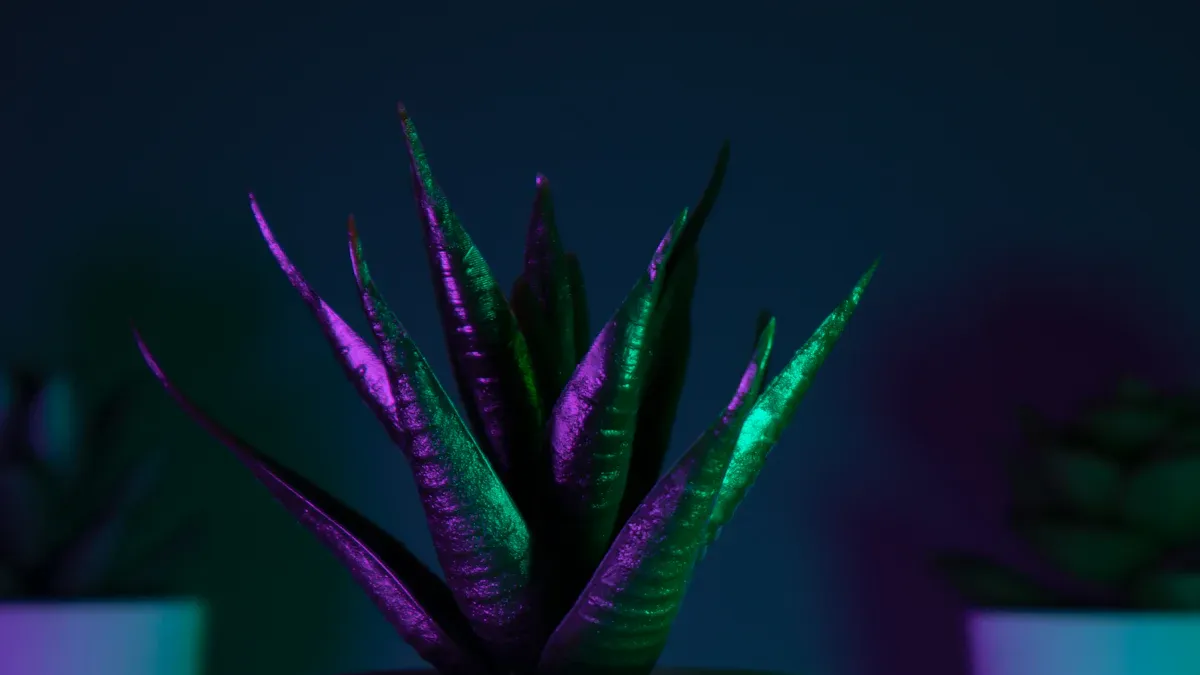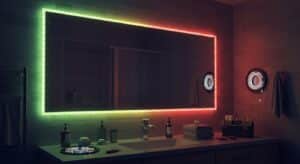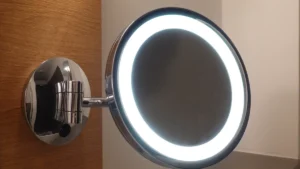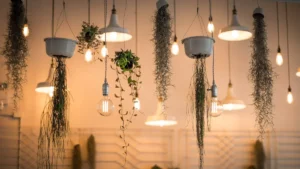
Battery-powered LED strip lights are easy-to-use, flexible lights. They work without needing a wall outlet for power. These lights use batteries to power energy-saving LEDs. This makes them great for portable or short-term setups. You can use them where regular lights don’t work well. Their light weight and simple design make them popular. People use them for crafts, decorating homes, or outdoor fun. Whether lighting a tent or decorating a room, they are super useful and convenient.
Key Takeaways
Battery-powered LED strip lights are easy to carry and use. You can set them up fast without tools, making them great for decorating or lighting temporary areas.
LED strip lights save energy and use less power than regular bulbs. Using LEDs can lower energy costs and help the environment.
These lights can be used in many ways, like home decor, outdoor parties, or camping. They are flexible, so you can set them up creatively anywhere.
Setting up LED strip lights is easy. Clean the surface, cut them to fit, stick them on, connect the battery pack, and turn them on for quick lighting.
To make batteries last longer, dim the lights, turn them off when not needed, and use rechargeable batteries with high capacity.
Benefits of LED Strip Lights
Portability and ease of use
Battery-powered LED strip lights are super easy to carry. You can fit them in a bag or small drawer. They are light, so moving them is simple. Most strips have sticky backs for quick setup. Just peel and stick them on clean surfaces. No tools or experts are needed. Use them to decorate a dorm or light a tent. These lights adjust to your needs without any trouble.
Energy efficiency and cost-effectiveness
LED strip lights save a lot of energy. They use less power than older lights. For example:
LED strips need only 7-10 watts per foot.
Bar lights use 10-15 watts each.
A study showed dimming LED lights can cut power use by 75.65%. This lowers bills and helps the planet. For comparison:
Lighting Type | Power Use (watts) |
|---|---|
Regular Bulb | 60 |
LED Light | 12.5 |
CFL | 15 |
Switching to LEDs saves families money every year. In the UK, this could cut bills by £1 billion. It would also reduce carbon dioxide by 5 million tons. Choosing LED strips is smart and good for the Earth.
Versatility for various applications
LED strip lights can be used in many ways. They make homes look nice and set the mood. Use them to highlight cool features in a room. They’re great for outdoor parties and camping trips. Campers use them to light tents or paths. People love them for holiday decor and DIY crafts. You can bend them to fit any space. These lights are perfect for creative ideas and projects.
Easy steps to set up
Putting up LED strip lights is simple and quick. You don’t need any special skills to do it. Follow these steps:
Clean the surface: Make sure the spot is clean and dry. Dirt or water can make the sticky side not work well.
Cut to size: Use scissors to cut the strip to the right length. Look for the marked spots to avoid breaking the strip.
Stick it on: Take off the paper from the sticky side. Press the strip gently onto the clean surface so it sticks well.
Attach the battery pack: Connect the battery pack to the strip. Check the plus and minus signs to match them correctly.
Turn it on: Switch on the battery pack to see if it works. Move the strip if needed to get it just right.
Tip: For bumpy or curved areas, use clips or brackets. These help hold the strip in place and stop it from falling off.
If you need to move the strip, peel it off carefully and stick it again. But doing this too much can make it less sticky. For setups that last longer, try using stronger tape or special mounts.
This easy setup makes LED strip lights great for quick fixes or short-term use. Whether you’re sprucing up a room or lighting an outdoor area, it’s a stress-free process.
How LED Strip Lights Work
Basics of LED technology
LED strip lights work using a process called electroluminescence. Electricity passes through a semiconductor, creating light. Unlike old bulbs, LEDs don’t make much heat. This makes them safe and energy-saving. Each LED has a chip with two parts: p-type and n-type semiconductors. When power flows, electrons move and meet, creating light as photons. This lets LEDs run well on low-power sources like batteries.
LEDs have improved a lot over time:
They started as tiny indicator lights but now do much more.
New designs make them brighter, more efficient, and flexible.
Knowing these changes shows why LED strip lights are great for portable lighting.
Role of batteries in powering the lights
Batteries are key to making LED strip lights easy to use. The battery’s voltage must match the LED strip’s needs. For example, many strips use 12V batteries. A battery’s capacity, shown in milliampere-hours (mAh), tells how long it lasts.
To find battery life, check the LED strip’s power use in watts. Divide the battery’s mAh by the strip’s mA to estimate runtime. Some LED strips can last over 15 hours, even if expected to run less. This shows how efficient certain batteries, like D-cell ones, can be for LED strips.
Features like dimming and remote control
Modern LED strips often have dimming and remote control options. Dimming lets you change brightness for different needs. Use it for a cozy vibe or bright workspace. Remote controls let you adjust settings without touching the lights.
These features make LED strips more useful for many purposes. Whether decorating a room or lighting an outdoor event, they offer ease and flexibility.
Common Uses of LED Strip Lights
Decorating Homes and Adding Style
LED strip lights can change how your home looks. They add a modern and cool vibe. Use them to brighten certain spots or make rooms feel cozy. For example:
Hide lights behind pictures to make wall art glow softly.
Put them behind your bed for a gentle reading light.
Line bathroom edges with lights for safe nighttime use.
Place them under cabinets for a warm coffee station glow.
These lights can also highlight unique designs in your home. They make bedrooms look trendy and mix beauty with usefulness.
Lighting for Outdoor Parties
Battery-powered LED strip lights are great for outdoor fun. They are easy to carry and set up. Use them to light paths, decorate tables, or make your backyard party festive. They work well in places without power, like gardens or patios.
Wrap them around trees or fences to create a cozy outdoor vibe. These lights save energy and last long, so they’re perfect for events. They’re a dependable choice for any outdoor gathering.
Lights for Camping and Travel
LED strip lights are handy when you’re traveling or camping. They are small and easy to pack. Despite their size, they give bright light for many activities.
Feature | What It Offers |
|---|---|
Easy to Carry | Small size and handle make them simple to move. |
Bright Light | Strong LEDs provide enough light for outdoor tasks. |
Multi-Purpose | Great for camping, traveling, tailgating, and other outdoor uses. |
Some LED strips are tough and can handle rain or rough weather. Certain models even let you control them with your phone. Use them to light your tent or make your campsite cozy. These lights are a must-have for outdoor trips.
Seasonal and DIY projects
Battery-powered LED strip lights are great for holiday decor and crafts. They are easy to use and bend, helping you create fun designs. Whether for a festive event or a personal project, these lights make your ideas shine.
Seasonal Decorations
Use LED strip lights to make your holiday decorations special. They add a magical glow to any celebration. For example:
Christmas: Wrap them around your tree or windows for a cozy glow.
Halloween: Use orange and purple lights to make your porch spooky.
Thanksgiving: Add soft lights to your table or mantel for warmth.
Fourth of July: Decorate with red, white, and blue lights for style.
Tip: Pick waterproof lights for outdoor use to handle any weather.
DIY Projects
DIY fans love LED strip lights for their creative potential. These lights let you customize and make unique designs. Try these ideas:
Custom Wall Art: Use flexible strips to make glowing wall shapes.
Light-Up Furniture: Add lights under shelves or tables for a modern look.
Photo Displays: Frame your photos with lights to make them pop.
Costume Enhancements: Add lights to costumes for a cool, bright effect.
Note: Measure carefully before cutting the strip to avoid mistakes.
With these lights, you can turn simple items into amazing creations. Their flexibility makes them perfect for decorating and crafting.
Choosing the Right LED Strip Lights
Brightness and color options
When picking LED strip lights, think about brightness and color. Brightness is measured in lumens per foot. Color temperature (CCT) is shown in Kelvin (K). Warm colors like 2700K feel cozy. Cooler tones like 5000K work well for tasks.
Product SKU | Color CCT | Lumen / Foot | Luminous Efficacy | CRI |
|---|---|---|---|---|
UB-AS-27K90C | 2700K | 466 lm/ft | 104 | 98 |
UB-AS-30K90C | 3000K | 478 lm/ft | 108 | 94 |
UB-AS-35K90C | 3500K | 499 lm/ft | 112 | 95 |
UB-AS-40K90C | 4000K | 493 lm/ft | 114 | 97 |
UB-AS-50K90C | 5000K | 502 lm/ft | 116 | 95 |
Tip: A higher CRI (Color Rendering Index) shows colors better. This is great for decorating or taking photos.
Battery life and type considerations
Battery life is important for battery-powered LED strip lights. Low-power strips with strong batteries last longer. For example:
Lithium-ion batteries last a long time.
Low-power strips use less energy, saving battery life.
High-power strips use more energy and need recharging often.
Note: Use rechargeable batteries with high mAh ratings. They last longer and create less waste.
Length and flexibility of the strip
The length and flexibility of LED strip lights decide how you can use them. Flexible strips bend easily, like a tape measure. This makes them great for creative setups.
Flexible strips fit curved or uneven surfaces easily.
Long strips, like 30 LEDs per meter, can cover up to 32 feet.
Long strips may dim at the end, so plan for even lighting.
Tip: Use strips with voltage regulation for steady brightness on long setups.
Adhesive quality and mounting options
When setting up battery-powered LED strip lights, the adhesive is very important. It helps the lights stay in place for a long time. Most strips have sticky backs, making them easy to install. But not all adhesives stick well to every surface. Check if the surface is smooth, clean, and dry before sticking the strip. Dusty or wet areas won’t hold the adhesive well.
Tip: Try a small piece of the adhesive on your wall first. This ensures it won’t peel off paint or damage wallpaper.
For better safety and longer use, try these mounting ideas:
Aluminum heat sinks: These help cool the strips and stop overheating. This keeps the lights working longer.
Mounting channels: They hold the strips in place and manage heat. This keeps the brightness steady.
Waterproof strips: Use these in wet places like bathrooms or outside. They protect the lights from water damage.
Pick a safe spot for your LED strips. Keep them away from things that can catch fire or places with high heat. This lowers the chance of accidents and keeps them safe to use.
If the sticky backing doesn’t work well, try other ways to mount the strips. Use double-sided tape, clips, or brackets for extra support. These are great for bumpy or curved surfaces.
Choosing the right adhesive and mounting method makes your lights look good and stay secure. A proper setup improves how the lights work and keeps them safe for a long time.
Drawbacks and Maintenance of LED Strip Lights
Battery life limitations
Battery-powered LED strip lights are handy but depend on batteries. Bright settings or long strips use more power quickly. This makes batteries drain faster. Rechargeable batteries can wear out over time. They may not hold as much charge as before. Replacing batteries often can cost more and create waste. To avoid this, monitor usage and pick energy-saving options.
Tips for extending battery performance
You can make your LED strip lights last longer by trying these tips:
Use dimmer settings when you don’t need full brightness. This saves power.
Turn off the lights when you’re not using them.
Choose rechargeable batteries with high capacity, like lithium-ion ones. They last longer and reduce waste.
Check battery levels often and recharge or replace them when needed.
Keep the lights and batteries in a cool, dry place to avoid damage.
Tip: Take out the batteries if you won’t use the lights for a while. This prevents corrosion and helps them last longer.
Cleaning and maintaining the strips
Taking care of your LED strip lights keeps them working well. Dust and dirt can make them dimmer and weaken the sticky backing. Follow these steps to clean and maintain them:
Use a soft, dry cloth to wipe off dust regularly.
For tough stains, use a damp cloth with mild soap. Don’t use harsh cleaners.
Keep the lenses clean to make the lights shine brighter.
Check the sticky backing often. If it stops sticking, use double-sided tape or clips.
Note: Always unplug the battery pack before cleaning to stay safe.
By keeping up with these tips, your LED strip lights will last longer and work better.
Ensuring safe and proper usage
Using battery-powered LED strip lights safely helps them last longer. It also keeps you safe from possible dangers. Follow these simple tips to use them properly:
Pick certified products: Buy LED strips with safety marks like UL or CE. These marks show the product is safe for indoor or outdoor use.
Follow setup steps: Read and follow the instructions from the maker. Don’t crowd the strips, and leave space for air to avoid overheating.
Check often: Look at your LED strips and batteries for damage. Replace broken parts quickly to prevent accidents.
Use waterproof strips in wet spots: For bathrooms or outside, pick waterproof LED strips. Look for an IP65 rating or higher to protect against water.
Keep away from flammable things: Don’t place strips near curtains, paper, or other items that burn easily. Good wiring and placement lower fire risks.
Tip: Use surge protectors to shield your LED strips from power spikes, especially with rechargeable batteries.
Handle the lights carefully to avoid damage. Don’t bend the strips too much, as this can break the wires inside. Make sure the sticky backing is secure so the strips don’t fall or cause someone to trip.
By following these safety tips, you can enjoy your LED strip lights without worrying about problems.
Battery-powered LED strip lights are super handy and flexible. They add style with accent lighting, brighten spaces with backlighting, and focus light for tasks. These lights save energy and are better than old-style bulbs. Whether decorating, hosting parties, or doing crafts, they fit your needs easily.
Use Type | Advantages |
|---|---|
Accent Lighting | Makes spaces look stylish and attractive. |
Backlighting | Lights up behind objects for better visibility. |
Task Lighting | Gives bright light for work or hobbies. |
Decorative Lighting | Creates a cozy and fun atmosphere. |
High Brightness Task Lighting | Saves energy while replacing regular lights. |
Indirect Lighting | Offers soft light that’s easy on the eyes. |
Ultraviolet Inspection | Helps check quality in making products. |
Set and Costume Design | Adds cool effects for plays or shows. |
Plant Growth | Helps plants grow by giving needed light. |
Tip: Try these lights for different uses to match your needs. They mix usefulness with style, making them great for any space.
FAQ
What batteries are best for LED strip lights?
Rechargeable lithium-ion batteries work the best. They last longer and need fewer replacements. Alkaline batteries can be used but run out faster.
Can LED strip lights be cut to fit?
Yes, you can cut them at special marked spots. These marks keep the strip working after cutting. Always check the maker’s instructions before cutting.
Are battery-powered LED strip lights water-resistant?
Some are waterproof, but not all. Look for an IP65 or higher rating for outdoor or wet use.
How long do batteries last in LED strip lights?
Battery life depends on the type and power use of the strip. Most batteries last 10-15 hours on medium brightness.
Are LED strip lights good for permanent setups?
Battery-powered LED strips are better for short-term use. For permanent setups, plug-in LED strips are more reliable and durable.
See Also
Adjustable Brightness Cob Led Strip Lighting Solutions
Selecting The Perfect LED Strip Lights For Linear Lighting
Understanding The Functionality Of Cob Led Strip Lights
Comparing Bright LED Strips For Various Uses And Needs
Effective Installation Tips For RGB LED Strip Lights



